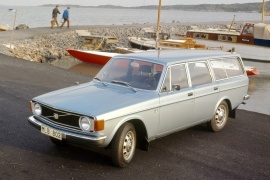VOLVO 145 Models/Series Timeline, Specifications & Photos
First production year: 1967
Engines: Gasoline
Body style: Wagon (station wagon, estate, combi, touring)
Volvo introduced the 140 series as a replacement for the Amazon and built it in a few shapes, including a station wagon that was highly appreciated due to its huge trunk space.
Along with the launch of the 140 series, the Swedish carmaker introduced a new naming system. The first letter was the vehicle's series; the second stood for the number of cylinders, while the third counted the number of doors fitted. Thus, the 142 was the coupe, the 144 was the four-door sedan, and the 145 was the station wagon.
There was also a new design language that heralded a long line of Volvo products up to the '90s. With its wedged shapes, flat body panels, and side windows, the car looked like a brick, but people loved it. It inspired the car's safety, which was one of the carmaker's key features. It still kept the rounded headlights at the front, like its siblings, but the most important difference was behind the B-pillars. The long roof version featured slimmer C-pillars and an additional row of side windows behind them. Last but not least, the flat, vertical tailgate offered a wide opening, with the taillights mounted on the corners of the quarter panels. Unusually for those times, the 145 featured rubber-covered chromed metallic bumpers.
Inside, the carmaker kept the same wedged shapes of the exterior. It even offered, for the upper trim levels, a center stack that hosted the ventilation controls. The flat bucket seats at the front inspired the one behind the wheel to drive slower since they didn't offer any side support. At the back, the flat-folding rear bench expanded the trunk to more than two cubic meters (70 cu-ft).
Under the hood, Volvo installed the same 1.8-liter powerplant from the rest of the 140 range, and it was mated either with a four-speed manual, a four-speed manual with electrical overdrive, or a three-speed automatic.
